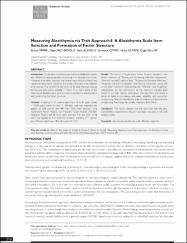| dc.contributor.author | Tatar, Arkun | |
| dc.contributor.author | Saltukoğlu, Gaye | |
| dc.contributor.author | Alioğlu, Seda | |
| dc.contributor.author | Çimen, Sümeyye | |
| dc.contributor.author | Güven, Hülya | |
| dc.contributor.author | Ay, Çağla Ebru | |
| dc.date.accessioned | 2020-11-24T11:52:49Z | |
| dc.date.available | 2020-11-24T11:52:49Z | |
| dc.date.issued | 2017 | en_US |
| dc.identifier.citation | TATAR, Arkun, Gaye SALTUKOĞLU, Seda Alioğlu, Sümeyye ÇİMEN, Hülya GÜVEN, & Çağla Ebru AY. "Measuring Alexithymia via Trait Approach-I: A Alexithymia Scale Item Selection and Formation of Factor Structure." Nöropsikiyatri Arşivi, 54.3 (2017): 216-224. | en_US |
| dc.identifier.uri | http://europepmc.org/backend/ptpmcrender.fcgi?accid=PMC5630099&blobtype=pdf | |
| dc.identifier.uri | https://hdl.handle.net/11352/3215 | |
| dc.description.abstract | Introduction: It is not clear in the literature whether available instruments are sufficient to measure alexithymia because of its theoretical structure. Moreover, it has been reported that several measuring instruments are needed to measure this construct, and all the instruments have different error sources. The old and the new forms of Toronto Alexithymia Scale are the only instruments available in Turkish. Thus, the purpose of this study was to develop a new scale to measure alexithymia, selecting items and constructing the factor structure.
Methods: A total of 1117 patients aged from 19 to 82 years (mean = 35.05 years) were included. A 100-item pool was prepared and applied to 628 women and 489 men. Data were analyzed using Explanatory Factor Analysis, Confirmatory Factor Analysis, and Item Response Theory and 28 items were selected. The new form of 28 items was applied to 415 university students, including 271 women and 144 men aged from 18 to 30 (mean=21.44).Results: The results of Explanatory Factor Analysis revealed a five-factor construct of "Solving and Expressing Affective Experiences,” "External Locused Cognitive Style,” "Tendency to Somatize Affections,” "Imaginary Life and Visualization,” and "Acting Impulsively,” along with a two-factor construct representing the "Affective” and "Cognitive” components. All the components of the construct showed good model fit and high internal consistency. The new form was tested in terms of internal consistency, test-retest reliability, and concurrent validity using Toronto Alexithymia Scale as criteria and discriminative validity using Five-Factor Personality Inventory Short Form.
Conclusion: The results showed that the new scale met the basic psychometric requirements. Results have been discussed in line with related studies. | en_US |
| dc.language.iso | eng | en_US |
| dc.publisher | Aves | en_US |
| dc.rights | info:eu-repo/semantics/openAccess | en_US |
| dc.subject | Alexithymia | en_US |
| dc.subject | Alexithymia Scale | en_US |
| dc.subject | Affective | en_US |
| dc.subject | Cognitive | en_US |
| dc.title | Measuring Alexithymia via Trait Approach-I: A Alexithymia Scale Item Selection and Formation of Factor Structure | en_US |
| dc.type | article | en_US |
| dc.contributor.department | FSM Vakıf Üniversitesi, Edebiyat Fakültesi, Psikoloji Bölümü | en_US |
| dc.relation.publicationcategory | Makale - Uluslararası Hakemli Dergi - Kurum Öğretim Elemanı | en_US |
| dc.contributor.institutionauthor | [0-Belirlenecek] | |



















